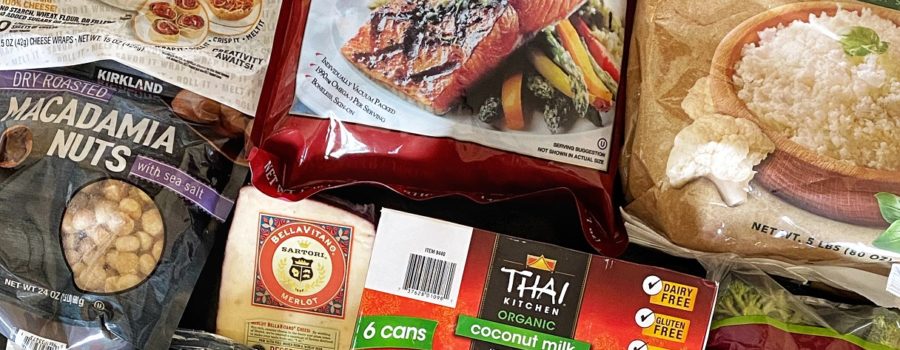The spread of Coronavirus (COVID-19) is likely on your mind. It’s important to take practical precautions recommended by the CDC, while also maintaining a positive perspective. Stressing yourself out with fear or anxiety doesn’t help the situation and also hampers your immune system function.
Keeping that in mind, one of the precautions you may be taking is making less trips to public places, one of which may be your regular grocery store. This may also mean you’re stocking up on more food items that are freezer safe and shelf stable, supporting less frequent outings if needed. If this is true, we urge you to keep nutrition in mind as part of your preparation.
Your initial solution may be to purchase frozen meals and processed, shelf-stable items. Many of these commercial products are full of questionable ingredients and often contain much higher amounts of salt and sugar and lower amounts of quality nutrients than our bodies require. This is a problem considering we need our bodies and immune systems to be as high functioning as possible right now!
Create a More Nutritional Grocery List
Here is a list of items to consider for your grocery list. Whole Foods and Costco are great places to find these items. You may also find additional options at your favorite store.
- Shelf stable products
- Canned seafood – sardines, tuna, wild salmon, etc.
- Nut butters – some may require refrigeration after opening (check label)
- Jarred sauces – tomato products, pasta sauces, Indian or Thai simmer sauces, etc.
- Coconut milk – great alternative to cow’s milk and can be used in so many ways!
- Chicken and beef bone broth, or vegetable stock
- Dried or canned beans
- Pasta/rice (*see note)
- Red wine – just kidding (maybe…hello, resveratrol and polyphenols!), sorry but we had to bring a little lightheartedness into the subject!
- Fresh produce with a longer life
- Potatoes/Sweet Potatoes
- Onions
- Garlic
- Fresh produce that will last longer when refrigerated:
- Limes/lemons
- Avocados
- Apples
- Whole carrots
- Eggs
- Frozen vegetables and fruit – frozen produce is a fantastic food option to have on hand. It solves the problem of fresh produce going bad, it’s often picked at prime ripeness and flash frozen, meaning many of the nutrients remain intact and it doesn’t include the added salt or preservatives often found in canned items. When it comes to fruit, remember some key points. Fruit in its whole form has many valuable nutrients, but it’s still a source of sugar. Consuming high-sugar fruits and any kind of fruit juice elevates your blood sugar, and prolonged elevated blood sugar can lead to a number of health issues over time. Along with this, certain fruits are higher in sugar than others, so those lower in sugar are suggested here.
- Cauliflower rice – a fantastic substitute for traditional rice
- Kale
- Spinach
- Broccoli
- Bell pepper slices
- Green beans
- Mushrooms
- Brussels sprouts
- Asparagus
- Butternut squash
- Avocado chunks
- Berries (strawberries, blueberries, raspberries, blackberries or a medley)
- Aronia berries
- Items you can purchase fresh (or frozen) and then freeze:
- Meat – ground beef/pork/turkey/chicken, cuts of meat (steaks, chicken thighs or breasts), etc.
- Frozen Seafood
- Cheese – shredded cheddar, mozzarella, jack, Gouda and many other cheeses do well in the freezer
- Bananas – slice them and take them out to use in a smoothie or eat with nut butter as needed (note – bananas are high in sugar, so limit to half a banana per serving)
- Bread – slice it if it isn’t already, then pull out slices as needed
- Nuts – nuts last longer in the freezer and I actually prefer them straight from the freezer for the stronger crunch!
*A note on pasta and rice: it’s okay to have these on hand to make some meals using the rice and pasta in small portions, but also work to get creative with other meals you can make that don’t require these grains. Soups, meatloaf and casseroles focused more on veggies are all great options. Also, we love cauliflower rice in our household – we find it tastes great with so many meals that traditionally would be served with rice, pasta or bread, or where you might crave a carb (curries, meatballs, stir fry, as a side to a protein, etc.).
Learn How to Use and Cook Frozen Fruits and Veggies
If you typically use fresh fruits and vegetables and are unsure how to use the frozen variety, here are some suggestions:
- Smoothies – remember to incorporate more veggies than fruits
- Thaw a portion of vegetables and saute in butter or oil, season to your liking
- If you don’t have time to thaw, throw the frozen veggies into your pan, slowly heat until any water has been released and begins to evaporate, then incorporate your fat to finish cooking
- Incorporate them into other meals – wilt some spinach or kale into your soups and stews, blend it into your sauces for your pastas or in your lasagna, cook some spinach into your scrambled eggs
- Make stir-fry
Make Freezer Meals
Consider carving out a little time in your week to make some freezer meals. Here are some examples of meals that work well when frozen:
- Soups and stews (try our Super Simple Green Curry!)
- Casseroles
- Curries (try our Butter Chicken with Cauliflower Rice)
- Taco or fajita meat
- Enchiladas
- Meatballs
- Egg cups/muffins
- Quiche
Good nutrition is a cornerstone of health. We may not be able to control the negativity and hyperreactivity happening in conjunction with the virus, but we can do our part to prevent its spread into our household and maintain our health by reducing stress, getting adequate sleep, staying active (moving your body), washing your hands and eating well.
Stay Healthy!







